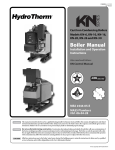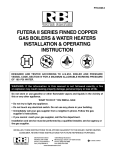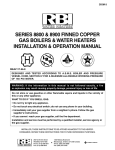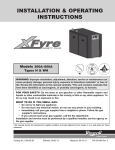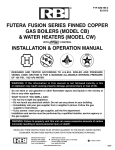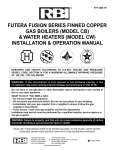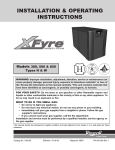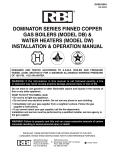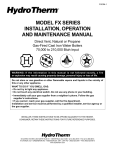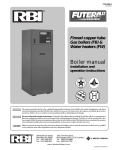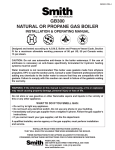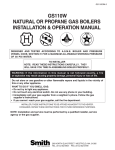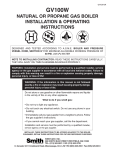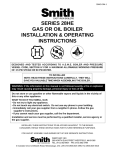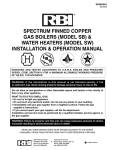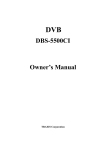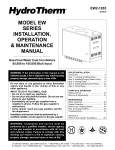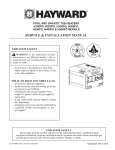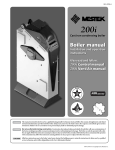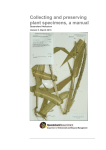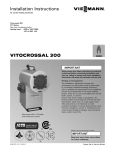Download kn series gas boiler installation & operating instructions
Transcript
KN2-805 KN SERIES GAS BOILER INSTALLATION & OPERATING INSTRUCTIONS MEA #163-04-E MASS Plumbers #G1-06-04-28 DESIGNED AND TESTED ACCORDING TO A.S.M.E. BOILER AND PRESSURE VESSEL CODE, SECTION IV FOR A MAXIMUM ALLOWABLE WORKING PRESSURE OF 100 PSI, 700 kPa, WATER. WARNING: If the information in this manual is not followed exactly, a fire or explosion may result causing property damage, personal injury or loss of life. Do not store or use gasoline or other flammable vapors and liquids in the vicinity of this or any other appliance. WHAT TO DO IF YOU SMELL GAS: • Do not try to light any appliance. • Do not touch any electrical switch. Do not use any phone in your building. • Immediately call your gas supplier from a neighbor’s phone. Follow the gas supplier’s instructions. • If you cannot reach your gas supplier, call the fire department. Installation and service must be performed by a qualified installer, service agency or the gas supplier. CAUTION: Do not use automotive anti-freeze in the boiler waterways. If the use of antifreeze is necessary an anti-freeze specifically formulated for hydronic heating systems must be used or damage to the boiler may occur voiding the warranty! INSTALLER, THESE INSTRUCTIONS TO BE AFFIXED ADJACENT TO THE BOILER / WATER HEATER. CONSUMER, RETAIN THESE INSTRUCTIONS FOR FUTURE REFERENCE PURPOSES. IN UNITED STATES: 260 NORTH ELM ST. • WESTFIELD, MA 01085 • (413) 564-5515 • FAX (413) 568-9613 IN CANADA: 5211 CREEKBANK RD. • MISSISSAUGA, ONT. L4W 1R3 • (905) 625-2991 • FAX (905) 625-6610 www.hydrotherm.com Page 2 KN INSTALLATION AND OPERATION INSTRUCTIONS AVERTISSMENT. Assurez-vous de bien suivre les instructions données dans cette notice pour réduire au minimum le risque d’incendie ou d’explosion ou pour éviter tout dommoge matériel, toute blessure ou la mort Ne pas entreposer ni utiliser d’essence ou ni d’autres vapeurs ou liquides inflammables à proximité de cet appareil ou de tout autre appareil. QUE FAIRE SI VOUS SENTEZ UNE ODEUR DE GAZ: • Ne pas tenter d’allumer d’appareil. • Ne touchez à aucun interrupteur; ne pas vous servir des téléphones se trouvant dans le bâtiment. • Appelez immédiatement votre fournisseur de gas depuis un voisin. Suivez les intructions du fournisseur. • Si vous ne purvez rejoindre le fournisseur, appelez le service des incendies. L’installation et l’entretien doivent être assurés par un installateur ou un service d’entretien qualifié ou par le fournisseur de gaz. CONTENTS Before Your Start ................................................ page 2 Ratings & Capacities .......................................... page 3 Location .............................................................. page 3 Combustion Air & Ventilation .............................. page 3 Venting Guidelines ............................................. page 5 Common Vent Systems .................................... page 12 General Piping Requirements .......................... page 13 Heating System Piping ..................................... page 13 Domestic Water Supply Piping ......................... page 16 Condensate Piping ........................................... page 17 Gas Supply Piping ............................................ page 17 Electrical Wiring ............................................... page 18 Boiler Operation ............................................... page 18 Operating Instructions ...................................... page 19 Sequence of Operation .................................... page 21 Checking & Adjustment .................................... page 22 Diagnostics ....................................................... page 23 Maintenance ..................................................... page 24 Troubleshooting ................................................ page 25 Repair Parts ..................................................... page 26 Wiring ........................................................ pages 29-32 BEFORE YOU START This manual covers the application, installation, operation and maintenance of a KN series boiler. To obtain the safe, dependable, efficient operation and long life for which this boiler was designed, these instructions must be read, understood and followed. The KN boiler series has been design certified by CSA for use with natural and propane gas under the latest revision of ANSI-Z21.13/CSA 4.9, Gas-Fired Low Pressure Steam and Hot Water Boilers and CAN1-3.1, Industrial and Commercial Gas Fired Packaged Boilers. Each unit has been constructed and hydrostatically tested for a maximum working pressure of 100 psi, 700 kPa, in accordance with Section IV of the A.S.M.E. Boiler and Pressure Vessel Code. All aspects of the boiler installation must conform to the requirements of the authority having jurisdiction, or, in the absence of such requirements, to the National Fuel Gas Code, ANSI Z223.1/NFPA 54-latest revision. Where required by the authority having jurisdiction, the installation must conform to the Standard for Controls and Safety Devices for Automatically Fired Boilers, ANSI/ASME CSD-1. If installed in the Commonwealth of Massachusetts, you MUST FOLLOW the additional instructions contained in HydroTherm’s instruction sheet MACODE-1. If you don’t have a copy call your HydroTherm distributor or HydroTherm. In Canada, the installation must be in accordance with the requirements of CSA B149.1 or .2, Installation Code for Gas Burning Appliances and Equipment. The owner should maintain a record of all service work performed with the date and a description of the work done. Include the name of the service organization for future reference. Direct all questions to your HydroTherm distributor or contact the HydroTherm Customer Service Department at: 260 North Elm Street, Westfield, MA 01085. Always include the model and serial numbers from the rating plate of the boiler in question. KN INSTALLATION AND OPERATION INSTRUCTIONS RATINGS & CAPACITIES Before installing the KN boiler check the rating plate to ensure that the unit has been sized properly for the job. Also ensure that the unit has been set up for the type of gas available at the installation site. Other important considerations are the availability of an adequate electrical supply, fresh air for combustion and a suitable chimney or vent system. BOILER LOCATION 1. This boiler is suitable for indoor installations only. Locate the boiler in an area that provides good access to the unit. Servicing may require the removal of jacket panels. Allow the minimum clearances between adjacent construction and the boiler as listed in Table 1. NOTE: Service clearances are not mandatory, but are recommended to ensure ease of service should it be required. Table 1 - Clearances Top Back Left Side Right Side Front Flue Clearance to Combustibles in mm 6 153 6 153 6 153 6 153 6 153 6 153 Service Clearance in mm 24 610 24 610 24 610 24 610 36 914 2. An optimum site will be level, central to the piping system, close to a chimney or outside wall and have adequate fresh air for combustion. Ensure that the unit is level from front to back and from side to side. Use metal shims if leveling is required. Electrical and electronic components must be protected from exposure to water during operation and maintenance. DO NOT install this boiler in a location that would subject any of the gas ignition and other electronic components to direct contact with water or excessive moisture during operation or servicing. 3. Ensure that the floor is structurally sound and will support the weight of the boiler. NOTE: The KN may be installed directly on combustible flooring, but never on carpeting. 4. Locate the boiler in an area that will prevent water damage to adjacent construction should a leak occur or during routine maintenance. Page 3 5. DO NOT place this boiler in a location that would restrict the introduction of combustion air into the unit or subject it to a negative pressure unless the combustion air is piped from the outside, see the COMBUSTION AIR & VENTILATION section. 6. NEVER place this boiler in a location that would subject it to temperatures at or near freezing. See the FREEZE PROTECTION SECTION on page 7. WARNING: Never store combustible materials, gasoline or any product containing flammable vapors or liquids in the vicinity of the boiler. Failure to comply with this warning can result in an explosion or fire causing extensive property damage, severe personal injury or death! COMBUSTION AIR & VENTILATION WARNING: This boiler must be supplied with combustion air in accordance with Section 5.3, Air for Combustion & Ventilation, of the latest revision of the National Fuel Gas Code, ANSI Z223.1/NFPA 54 and all applicable local building codes. Canadian installations must comply with CSA B149.1 or .2 Installation Code for Gas Burning Appliances and Equipment, or applicable provisions of the local building codes. Failure to provide adequate combustion air for this boiler/water heater can result in excessive levels of carbon monoxide which can result in severe personal injury or death! To operate properly and safely this boiler requires a continuous supply of air for combustion. NEVER store objects on or around the boiler! CAUTION: Combustion air contaminated with fluorocarbons or other halogenated compounds such as cleaning solvents and refrigerants will result in the formation of acids in the combustion chamber. These acids will cause premature failure of the boiler voiding the warranty! CAUTION: If the boiler is operated while the building is under construction it must be protected from wood, concrete, sheet rock and other types of dust. Failure to properly protect the unit from construction dust will damage the unit voiding the warranty! Page 4 KN INSTALLATION AND OPERATION INSTRUCTIONS Buildings will require the installation of a fresh air duct or other means of providing make-up air if the intake air option isn't used. Any building utilizing other gas burning appliances, a fireplace, wood stove or any type of exhaust fan must be checked for adequate combustion air when all of these devices are in operation at one time. Sizing of an outside air duct must be done to meet the requirements of all such devices. WARNING: Never operate the KN-10 in an environment subjected to a negative pressure unless it is Direct Vented. Failure to comply with this warning can result in excessive levels of carbon monoxide causing severe personal injury or death! All Air From Inside The Building If the boiler is to be located in a confined space the minimum clearances listed in Table 1 must be maintained between it and any combustible construction. When installed in a confined space without the intake air option two permanent openings communicating with an additional room(s) are required. The combined volume of these spaces must have sufficient volume to meet the criteria for an unconfined space. The total air requirements of all gas utilization equipment, fireplaces, wood stoves or any type of exhaust fan must be considered when making this determination. Each opening must have a minimum free area of 1 in2/1000 Btu/hr, 2200 mm2/kW based on the total input rating of ALL gas utilization equipment in the confined area. Each opening must be no less than 100 in2, 64,516 mm2 in size. The upper opening must be within 12 in, 300 mm of, but not less than 3 in, 80 mm from, the top of the enclosure. The bottom opening must be within 12 in, 300 mm of, but not less than 3 in, 80 mm from, the bottom of the enclosure. All Air From Outside The Building When installed in a confined space without the intake air option two permanent openings communicating directly with, or by ducts to, the outdoors or spaces that freely communicate with the outdoors must be present. The upper opening must be within 12 in, 300 mm of, but not less than 3 in, 80 mm from, the top of the enclosure. The bottom opening must be within 12 in, 300 mm of, but not less than 3 in, 80 mm from, the bottom of the enclosure. Where directly communicating with the outdoors or communicating with the outdoors through vertical ducts, each opening shall have a minimum free area of 1 in2/ 4000 Btu/hr, 550 mm2/kW of the total input rating of all of the equipment in the enclosure. Where communicating with the outdoors through horizontal ducts, each opening shall have a minimum free area of 1 in2/2000 Btu/hr, 1100 mm2/kW of the total input rating of all of the equipment in the enclosure. When ducts are used, they must have the same crosssectional area as the free area of the opening to which they connect. Table 2 - Make-up Air Duct Sizing Required Cross Sectional Duct Area Input 1/4 in, 6.4 mm Metal Wooden (MBH) Wire Screen Louvers Louvers in2 cm2 in2 cm2 in2 cm2 600 150 967 200 1292 600 3869 1000 250 1612 334 2154 1000 6448 2000 500 3224 668 4308 2000 12,896 When calculating the free area necessary to meet the make-up air requirements of the enclosure, consideration must be given to the blockage effects of louvers, grills and screens. Screens must have a minimum mesh size of 1/4 in, 6.4 mm. If the free area through a louver or grill is not known ducts should be sized per Table 2 above. Direct Intake Air Option - General This configuration provides combustion air directly to the boiler’s air intake using a dedicated pipe when using the direct vent option. Combustion air can be drawn in horizontally through an outside wall or vertically through the roof, see Figures 1, 2, 3 & 4. It must be sized per Table 3. WARNING: Each boiler must have it’s own intake air system. Common intake air systems are not to be used! Improper installation can result in excessive levels of carbon monoxide which can cause severe personal injury or death! Single wall galvanized smoke pipe, single wall aluminum pipe, flexible aluminum pipe, PVC or CPVC pipe can be used for the intake air pipe. Table 3 - Intake Air Pipe Sizing Model Pipe Diameter Size in2 mm2 600 5 127 1000 6 152 2000 9 229 All joints in metal intake air systems must be secured using corrosion resistant fasteners and sealed using a suitable Silicone caulk. If PVC or CPVC is used, the joints must be cleaned with a suitable solvent and connected using a solvent based PVC cement. The intake air system MUST be supported by the building structure not the boiler. KN INSTALLATION AND OPERATION INSTRUCTIONS Direct Intake Air Option - Vertical The maximum equivalent length for the vertical intake air pipe is 80 ft, 19.7 m. Each 90° mitered elbow and the intake air cap are equal to 10 ft, 3.3 m of straight pipe. If 90° long sweep elbows are installed use the manufacturers recommended equivalent length. A listed, nonrestrictive intake air cap must be used. The intake air cap must terminate as shown in Figure 3. The penetration point in the roof must be properly flashed and sealed. Approved caps are listed in Table 4. Direct Intake Air Option - Horizontal The maximum equivalent length for the horizontal intake air pipe is 80 ft, 19.7 m. Each 90° mitered elbow and the intake air terminal are equal to 10 ft, 3.3 m of straight pipe. If 90° long sweep elbows are installed use the manufacturers recommended equivalent length. Horizontal runs that exceed 5 ft, 1.5 m must be supported at 3 ft, 0.98 m intervals with overhead hangers. The intake air terminal must terminate as shown in Figures 1, 2 or 4. Approved terminals are listed in Table 5. Table 4 - Vertical Intake & Vent System Components Company Description Part Number Dia., in Flex-L 5 Flex-L 6 Flex-L 9 Heat Fab Rain Cap 5500CI 5 Heat Fab Rain Cap 5600CI 6 Heat Fab Rain Cap 51000CI 9 Pro Tech Rain Cap FSRC5 5 Pro Tech Rain Cap FSRC6 6 Pro Tech Rain Cap FSRC10 9 Z Flex 5 Z Flex 6 Z Flex 9 GENERAL VENTING GUIDELINES WARNING: The vent installation must be in accordance with Part 7, Venting of Equipment, of the National Fuel Gas Code, ANSI Z223.1/NFPA 54-latest revision or applicable provisions of the local building codes. Canadian installations must comply with CSA B149.1 or .2 Installation Code. Improper venting can result in excessive levels of carbon monoxide which can result in severe personal injury or death! All vent systems must be fully supported by the building structure and not by the boiler. Appropriate thimbles and fire-stops must be used where required. Table 5 - Horizontal Intake & Vent System Components Company Description Part Number Flex-L Vent Adapter Flex-L Vent Adapter Flex-L Vent Adapter Termination T Termination T Termination T Termination EL Termination EL Termination EL Heat Fab Vent Adapter 9501KN10 Heat Fab Vent Adapter 9601KN10 Heat Fab Vent Adapter 91001KN10 Termination T 9590TEE Termination T 9690TEE Termination T 90990TEE Termination EL 7514TERM Termination EL 9614TERM Termination EL 90914TERM Pro Tech Vent Adapter Pro Tech Vent Adapter FSA-HFAG Pro Tech Vent Adapter Termination T 300313 Termination T 300314 Termination T Termination EL Termination EL Termination EL Z Flex Vent Adapter Vent Adapter Vent Adapter Termination T 02SVSTTX05 Termination T Termination T Termination EL Termination EL Termination EL Page 5 Dia., in 5 6 9 5 6 9 5 6 9 5 6 9 5 6 9 5 6 9 5 6 9 5 6 9 5 6 9 5 6 9 WARNING: Each boiler must have it’s own vent system. Common positive pressure vent systems are not to be used! Improper installation can result in excessive levels of carbon monoxide which can cause severe personal injury or death! Note: A single acting barometric damper must be installed in the vent connector if a vertical vent system produces a draft in excess of 0.08 in, 2.03 mm W.C at the flue outlet. Note: One of the vent system adapters listed in Table 5 must be attached to the flue outlet of the boiler before the vent system is connected. Page 6 KN INSTALLATION AND OPERATION INSTRUCTIONS VENT SYSTEM OPTIONS The KN may be vented the following ways: 1) Direct Vent - Positive Pressure, Category IV uses a vent system certified to UL 1738 for installations in the United States, ULS636 for installations in Canada. Combustion air is piped from the outdoors to the blower inlet. 2) Side Wall Vent - Positive Pressure, Category IV uses a stainless steel vent system certified to UL 1738 for installations in the United States, ULS636 for installations in Canada. Combustion air is obtained from the space in which the unit is installed. 3) Vertical Vent - Positive Pressure, Category IV uses a stainless steel vent system certified to UL 1738 for installations in the United States, ULS636 for installations in Canada. Combustion air is obtained from the space in which the unit is installed. 4) Vertical Vent - Negative Pressure, Category II uses an approved metal chimney system. Combustion air is obtained from the space in which the unit is installed. DIRECT VENT POSITIVE PRESSURE, CATEGORY IV In this configuration the boiler blower is used to push the flue products to the outdoors while drawing combustion air from the outdoors. The INTAKE AIR OPTION instructions under the COMBUSTION AIR & VENTILATION SECTION must be followed! The vent system must be sized per Table 6. Table 6 - Direct Vent Pipe Size, Positive Pressure Model Pipe Diameter Size in2 mm2 600 5 127 1000 6 152 2000 9 229 Horizontal Direct Vent Systems - Figures 1 & 2 The vent materials used in positive pressure vent systems must be certified to UL 1738 for installations in the United States, ULS636 for installations in Canada. The vent terminals listed in Table 5 must also be used. Below is a list of some of the manufactures that have systems that meet these requirements. Others manufacturers that have UL certified systems may be used. Heat-Fab, Inc. 38 Hayward Street Greenfield, MA 01301, (800) 772-0739. Z-Flex U.S., Inc. 20 Commerce Park North, Bedford, NH 03110-6911, (800) 654-5600. Protech Systems Inc. 26 Gansevoort Street Albany, NY 12202 (518) 463-7284 Flex-L International Inc. 6385 Kennedy Road Missis-sauga, ON Canada L5T 2W4 (800) 561-1980 The maximum equivalent length for the horizontal vent pipe is 80 ft, 19.7 m. Each 90° elbow and the vent terminal are equal to 10 ft, 3.3 m of straight pipe. To maximize the performance of single wall sheet metal vent systems locate 90° elbows as far from the boiler as possible and from one another. For best results, horizontal vent systems should be as short and straight as possible. The vent system must be both gas and water tight. All seams and joints in metal pipes must be joined and sealed in accordance with the vent system manufacturer’s instructions. When horizontal vent runs exceed 5 ft, 1.5m they must be supported at 3 ft, 0.98 m intervals with overhead hangers. The vent system must be pitched down, toward the vent terminal, 1/4 in/ft, 21mm/m. If any part of a single wall metal vent system passes through an unheated space it must be insulated with insulation rated for 400°F, 20°C. Horizontal vent systems shall terminate at least 4 ft, 1.3 m below, 4 ft, 1.3 m horizontally from or 1 ft, 0.23 m above any door, window or gravity air inlet into any building. It must not terminate less than 4 ft, 1.3 m horizontally from, and in no case above or below, unless a 4 ft, 1.3 m horizontal distance is maintained, from electric meters, gas meters, regulators and relief equipment and not less than 7 ft, 2.3 m from any adjacent public walkway. The bottom of the vent terminal(s) shall be located at least 5 ft, 1.5 m above the air intake terminal(s) unless there is a 5 ft, 1.5 m distance between them. Avoid terminal locations likely to be affected by winds, snowdrifts, people and pets. Protect building materials and vegetation from degradation caused by the flue gases. KN INSTALLATION AND OPERATION INSTRUCTIONS Vertical Direct Vent Systems - see Figure 3 The vent materials used in positive pressure vent systems must be certified to UL 1738 for installations in the United States, ULS636 for installations in Canada. The vent terminals listed in Table 4 must also be used. Below is a list of some of the manufactures that have systems that meet these requirements. Others manufacturers that have UL certified systems may be used. Heat-Fab, Inc. 38 Hayward Street Greenfield, MA 01301, (800) 772-0739. Z-Flex U.S., Inc. 20 Commerce Park North, Bedford, NH 03110-6911, (800) 654-5600. Protech Systems Inc. 26 Gansevoort Street Albany, NY 12202 (518) 463-7284 Flex-L International Inc. 6385 Kennedy Road Missis-sauga, ON Canada L5T 2W4 (800) 561-1980 Page 7 The maximum equivalent length for the vertical vent pipe is 80 ft, 19.7 m. Each 90° elbow and the intake air cap are equal to 10 ft, 3.3 m of straight pipe. If any part of a single wall metal vent system passes through an unheated space it must be insulated with insulation rated for 400°F, 204°C. Structural penetrations must be made using approved fire-stops. The top of a vertical vent system must extend at least 51/2 ft, 1.8 m above the roof surface that it passes through, 4 ft, 1.3 m above the intake air cap, see Figure 3. In addition the vent system must conform to the dimensions shown in Figure 3. The penetration point in the roof must be properly flashed and sealed. The vent system must be gas tight. All seams and joints in metal pipes must be joined and sealed in accordance with the vent system manufacturer's instructions. Combination Direct Vent Systems - see Figure 4 The boiler can be vented vertically with the intake air piped horizontally through an outside wall. Follow the instructions in the INTAKE AIR OPTION - HORIZONTAL GUIDELINES on page 4. Also follow the general instructions in the COMBUSTION AIR & VENTILATION and GENERAL VENTING GUIDELINES sections. KN-10 Multiple Boiler Venting Category II Venting (Negative) NOTE: A NEGATIVE PRESSURE OF .02 TO .08 MUST BE PROVIDED FOR ALL BOILERS CONNECTED TO THE BREECHING WHEN ALL BOILERS ARE IN OPERATION AT FULL INPUT. Page 8 KN INSTALLATION AND OPERATION INSTRUCTIONS Figure 1 - Horizontal Air Intake and Venting for a Single Direct Vent System Figure 2 - Horizontal Air Intake and Venting for Multiple Direct Vent Systems MBH kW 146 TO 293 500 TO 1000 293 TO 586 1001 TO 2000 586 TO 1172 2001 TO 4000 4001 & LARGER 1172 & LARGER FT 5 10 15 20 m 1.5 3.1 4.6 6.1 5 FT 1.5 m 2 IN. 5.0 cm 1.5 FT 0.5 m KN INSTALLATION AND OPERATION INSTRUCTIONS Figure 3 - Vertical Air Intake and Venting for Direct Vent System Figure 4 - Combination Direct Vent Systems Page 9 Page 10 KN INSTALLATION AND OPERATION INSTRUCTIONS SIDE WALL VENT POSITIVE PRESSURE, CATEGORY IV In this configuration the boiler blower is used to push the flue products horizontally to the outdoors, see Figure 5. The air for combustion is taken from the space in which the unit is installed. The applicable instructions under the COMBUSTION AIR & VENTILATION SECTION must be followed! The vent guidelines under the HORIZONTAL DIRECT VENT SYSTEMS section must also be followed. Figure 5 - Side Wall Venting VERTICAL VENT POSITIVE PRESSURE - CATEGORY IV In this configuration the boiler blower is used to push the flue products vertically to the outdoors, see Figure 6. The air for combustion is taken from the space in which the unit is installed. The applicable instructions under the COMBUSTION AIR & VENTILATION SECTION must be followed! The vent guidelines under the VERTICAL DIRECT VENT SYSTEMS section must also be followed Figure 6 - Vertical Positive Pressure Venting KN INSTALLATION AND OPERATION INSTRUCTIONS Page 11 VERTICAL VENT NEGATIVE PRESSURE - CATEGORY II The vent system should be sloped up toward the chimney at a minimum rate of 1/4 in/ft, 2 cm/m. The KN is listed as a Category II appliance when vented vertically into a listed metal chimney system, Figure 7. The chimney system must provide a negative pressure of 0.02 to 0.15 in, 0.51 to 3.81 mm W.C. at the boiler flue collar with the unit running. WARNING: Never install a vent pipe of a diameter different than that specified in Table 7. Failure to comply with this warning can result in excessive levels of carbon monoxide which can cause severe personal injury or death. NOTE: When using a listed metal chimney system the chimney system manufacturer’s instructions must be followed. Always provide a minimum clearance of 6 in, 152 mm between single wall vent pipe and any combustible materials. Multiple KN’s can be vented into a single vertical chimney system. Refer to HydroTherm KN-10 Venting page 7. Consult factory for multiple KN-6 and KN-20 venting applications. WARNING: Failure to maintain minimum clearances between vent connectors and any combustible material can result in a fire causing extensive property damage, severe personal injury or death! When more than one appliance is connected to the same chimney system the system must be large enough to safely vent the combined output of all of the appliances. Table 7 lists the equivalent breeching and chimney sizes required for a single boiler installation. WARNING: If an appliance using any type of a mechanical draft system operating under positive pressure is connected to a chimney flue, never connect any other appliances to this flue. Doing so can result in excessive levels of carbon monoxide which can cause severe personal injury or death! Table 7 - Equivalent Breeching & Chimney Size, Negative Pressure - Single Boiler Model Breech & Flue Diameter Size in2 mm2 600 8 204 1000 12 305 2000 18 457 NOTE: These sizes are based on a 20 ft, 6.1m chimney height. Vent Connections Locate the boiler as close to the chimney system as possible. Use the shortest, straightest vent connector possible for the installation. If horizontal runs exceed 5 ft, 1.5 m they must be supported at 3 ft, 0.9 m intervals with overhead hangers. Use the appropriate vent connector of the same diameter as the flue collar to connect the boiler to a listed metal chimney system. Follow the chimney system manufacturer’s instructions for proper assembly. Figure 7 - Vertical Venting with a Metal Chimney System Page 12 KN INSTALLATION AND OPERATION INSTRUCTIONS l'espace où les appareils toujours raccordés du système d'évacuation sont installés et les autres espaces du bâtiment. Mettre en marche les sécheuses, tous les appareils non raccordés au système d'évacuation commun et tous les ventilateurs d'extraction comme les hottes de cuisinère et les ventilateurs des salles de bain. S'assurer que ces ventilateurs fonctionnent à la vitesse maximale. Ne pas faire fonctionner les ventilateurs d'été. Fermer les registres des cheminées. COMMON VENT SYSTEMS If an existing boiler is removed from a common venting system, the common venting system may then be too large for the proper venting of the remaining appliances connected to it. At the time of removal of an existing boiler, the following steps shall be followed with each appliance remaining connected to the common venting system placed in operation, while the other appliances remaining connected to the common venting system are not in operation. Au moment du retrait d'une chaudière existante, les mesures suivantes doivent être prises pour chaque appareil toujours raccordé au système d'évacuation commun et qui fonctionne alors que d'autres appareils toujours raccordés au système d'évacuation ne fonctionnent pas: système d'évacuation a) Seal any unused openings in the common venting system. Sceller toutes les ouvertures non utilisées du système d'évacuation. d) Place in operation the appliance being inspected. Follow the lighting instructions. Adjust thermostat so appliance will operate continuously. Mettre l'appareil inspecté en marche. Suivre les instructions d'allumage. Régler le thermostat de façon que l'appareil fonctionne de façon continue. e) Test for spillage at the draft hood relief opening after 5 minutes of main burner operation. Use the flame of a match or candle, or smoke from a cigarette, cigar or pipe. b) Visually inspect the venting system for proper size and horizontal pitch and determine there is no blockage or restriction, leakage, corrosion and other deficiencies which could cause an unsafe condition. Inspecter de façon visuelle le système d'évacu-ation pour déterminer la grosser et l'inclinaison horizontale qui conviennent et s'assurer que le système est exempt d'obstruction, d'étranglement de fruite, de corrosion et autres défaillances qui pourraient présenter des risques. c) Insofar as is practical, close all building doors and windows and all doors between the space in which the appliances remaining connected to the common venting system are located and other spaces of the building. Turn on clothes dryers and any appliance not connected to the common venting system. Turn on any exhaust fans, such as range hoods and bathroom exhaust, so they will operate at maximum speed. Do not operate a summer exhaust fan for a boiler installation. Close fireplace dampers. Dans la mesure du possible, fermer toutes les portes et les fenêtres du bâtiment et toutes les portes entre Faire fonctionner le brûleur principal pendant 5 min ensuite, déterminer si le coupe-tirage déborde à l'ouverture de décharge. Utiliser la flamme d'une allunette ou d'une chandelle ou la fumée d'une cigarette, d'un cigare ou d'une pipe. f) After it has been determined that each appliance remaining connected to the common venting system properly vents when tested as outlined above, return doors, windows, exhaust fans, fireplace dampers and any other gas-burning appliance to their previous condition of use. Une fois qu'il a été d éterminé, selon la métode indiquée ci-dessus, que chaque appareil raccordé au système d'évacuation est mis à l'air libre de façor adéquate. Remettre les portes et les fenêtres, les ventilateurs, les registres de cheminées et les appareils au gaz à leur position originale. KN INSTALLATION AND OPERATION INSTRUCTIONS g) Any improper operation of the common venting system should be corrected so the installation conforms with the National Fuel Gas Code, ANSI Z223.1/NFPA 54. When resizing any portion of the common venting system, the common venting system should be resized to approach the minimum size as determined using the appropriate tables in Appendix F in the National Fuel Gas Code, ANSI Z223.1/ NFPA 54 and or CSA B149 Installation Codes. Page 13 Figure 8 - Relief Valve Piping Tout mauvais fonctionnement du systéme d'évacution commun devrait étré corrigé de façor que l'installation soit conforme au National Fuel Gas Code, ANSI Z223.1/NFPA 54 et (ou) aux codes d'installation CSA-B149. Si la grosseur d'une section du système d' évacuation doit étré modifiée, le système devrait étré modifié pour respecter les valeurs minimales des tableaux pertinents de l'appendice F du National Fuel Gas Code, ANSI Z223.1/NFPA 54 et (ou) des codes d'installation CSA-B149. GENERAL PIPING REQUIREMENTS CAUTION: Improper piping of this boiler will void the manufacturer’s warranty and can cause boiler failure resulting in flooding and extensive property damage! NOTE: Shut off valves and unions should be installed at the inlet and outlet connections of the boiler to provide for isolation of the unit should servicing be necessary. Relief Valve Pipe the discharge of the pressure relief valve as shown in Figure 8. WARNING: Never install any type of valve between the boiler and the relief valve or an explosion causing extensive property damage, severe personal injury or death may occur! Flow Switch The flow switch supplied with the boiler is wired to prevent the boiler from firing unless there's adequate water flow through the unit. NOTE: Failure to maintain a minimum flow rate of 30 gpm, 1.9 L/s at the boiler outlet will prevent the flow switch from closing. If a minimum flow rate of 30 gpm, 1.9 L/s cannot be maintained at the boiler outlet the flow switch will have to be relocated in the system. HEATING SYSTEM PIPING General Piping Requirements All heating system piping must be installed by a qualified technician in accordance with the latest revision of the ANSI/ASME Boiler and Pressure Vessel Code, Section IV. Where required, the piping must comply with ANSI/ ASME CSD-1, Standard for Controls and Safety Devices for Automatically Fired Boilers. All applicable local codes and ordinances must also be followed. A minimum clearance of 1in, 25 mm must be maintained between heating system pipes and all combustible construction. All heating system piping must be supported by suitable hangers not the boiler. The thermal expansion of the system must be considered when supporting the system. A minimum system pressure of 12 psig, 84 kPa must be maintained at the highest point in the system piping. Page 14 KN INSTALLATION AND OPERATION INSTRUCTIONS Boiler Piping Connections The supply and return connections should be sized to suit the system, see Table 8. Table 8 - Supply & Return Pipe Sizing Model Supply Return Size Size Size 600 2" NPT 2" NPT 1000 3" NPT 3" NPT 2000 3" NPT 3" NPT Pump Requirements This boiler requires a continuous minimum water flow for proper operation. The system pump must be sized to overcome the head loss of the boiler and the heating system in order to achieve the required temperature rise. If the system contains hydronic antifreeze this must be considered when sizing the pump. The temperature rise across the boiler must never exceed 100°F, 55.6°C. Low Water Cutoff Each KN boiler comes equipped with a factory installed low water cutoff. Expansion Tank & Air Separator An expansion tank or other means to control thermal expansion must be installed in the heating system. An expansion tank must be installed close to the boiler on the suction side of the pump. An air scoop and automatic air vent must also be installed to eliminate air trapped in the system. Primary/Secondary Piping Figure 9 shows a typical primary/secondary piping system. A dedicated pump is used to maintain a constant water flow through the boiler. Systems using multiple boilers can be installed using a primary/ secondary manifold system, Figure 10. Reverse Return Piping Systems using multiple boilers can also be installed using a reverse return system, Figure 11. Piping For Use With Cooling Units The boiler, when used in connection with a refrigeration system, must be installed so the chilled medium is piped in parallel with the boiler. Appropriate valves must be used to prevent the chilled water from entering the boiler. When a boiler is connected to a heating coil that may be exposed to refrigerated air from an air handling device, the piping system must be equipped with flowcontrol valves or some other automatic means of preventing gravity circulation of the boiler water during the cooling cycle. NOTE: Minimum boiler flow rate is 15 gpm. Maximum boiler flow rate is 150 gpm. Figure 9 - Typical Single Boiler Primary/Secondary Piping NOTE: Not all system valves may be shown. Consult local codes for additional system components which may be necessary. KN INSTALLATION AND OPERATION INSTRUCTIONS Page 15 Figure 10 - Typical Multiple Boiler Primary/Secondary Piping NOTE: Not all system valves may be shown. Consult local codes for additional system components which may be necessary. Figure 11 - Typical Multiple Boiler Reverse Return Piping NOTE: Not all system valves may be shown. Consult local codes for additional system components which may be necessary. Page 16 KN INSTALLATION AND OPERATION INSTRUCTIONS DOMESTIC WATER SUPPLY PIPING CAUTION: Proper controls must be used to prevent water supplied for domestic use from exceeding 130°F, 54°C or a scald injury will occur! When higher water temperatures are required for appliances such as a dishwasher, a mixing valve or some other tempering means must be installed. Households with small children may require water temperatures less than 120°F, 49°C. Local codes must be complied with! General Piping Requirements The KN boiler can be use in combination with an indirect tank to provide hot water for domestic use. Piping and components must be suitable for use with potable water. The indirect storage tank must be equipped with a temperature and pressure relief valve that complies with ANSI Z21.22 or CAN-4.4 and CAN-4.6. NOTE: The storage tank must be located as close to the boiler as possible to prevent excessive head loss which will reduce flow. Expansion Tank An expansion tank or other means to control thermal expansion must be installed in the water heating system if back flow prevention devices are installed. Two typical water heating systems are shown in Figures 12 & 13. Thermostatic Mixing Valve- Water Above 140°F, 60°C Water can be stored a temperatures above 140°F, 60°C provided that a thermostatically controlled mixing valve is used to temper the hot water to an acceptable temperature before it's supplied for domestic use. The mixing valve MUST be set to prevent a scald injury from occurring, see the caution against scalding above. Storage of water for domestic use above 140°F, 60°C will provide an increased quantity of tempered water and help prevent the growth of water born bacteria. Figure 12 - Typical Single Boiler with Indirect Storage Tank Piping NOTE: Not all system valves may be shown. Consult local codes for additional system components which may be necessary. KN INSTALLATION AND OPERATION INSTRUCTIONS Page 17 Figure 13 - Typical Multiple Boiler with Indirect Storage Tank Piping NOTE: Not all system valves may be shown. Consult local codes for additional system components which may be necessary. CONDENSATE PIPING The condensate trap provided with the boiler must be attached to the bottom pan and piped to a suitable floor drain or condensate pump. GAS SUPPLY PIPING WARNING: Check the boiler rating plate to make sure that the boiler is for the type of gas that will be used. If it isn’t, do not connect the boiler to the gas supply. Failure to comply with this warning can result in extensive property damage, severe personal injury or death! Figure 14 depicts the proper way to connect the boiler to the gas supply piping. The manual shut-off valve MUST be installed in the supply piping. It should be installed 5 feet above the floor where required by local codes. Provide a sediment trap at the bottom of the vertical section of the gas supply pipe upstream of the gas controls. A ground joint union should be installed between the boiler gas controls and the supply piping. Each of these items are needed to ensure long life and ease of servicing. Always use a pipe sealant that is suitable for use with LP gas. Table 9 - Gas Pipe Capacity The KN comes from the factory ready to be piped to the gas supply. If for any reason the boiler is not for the type of gas available at the installation site, call your HydroTherm representative to resolve the problem. Table 9 should be used to ensure that the gas supply piping is sized properly. If more than one appliance is supplied by the same supply pipe, the piping must be sized based on the maximum possible demand. Do not neglect the pressure drop due to pipe fittings. Table 9 should be used in conjunction with Table 10 to ensure that the gas supply piping has the capacity to meet the demand. Maximum pipe capacity in ft3/hr based on 0.60 specific gravity gas at a pressure of 0.5 psig or less and a 0.3" WC pressure drop. Nominal Iron Pipe Size, (in) 10 1″ 11/4″ 11/2″ 2″ 520 1050 1600 3050 Pipe length in feet 20 30 40 50 60 80 100 Maximum gas volume of pipe (ft3/hr) 350 285 245 215 195 170 150 730 590 500 440 400 350 305 1100 890 760 670 610 530 460 2100 1650 1450 1270 1150 990 870 150 120 250 380 710 Note: Multiply the gas volume by 0.62 for propane flow capacity in ft3/hr.Multiply the propane flow capacity by 2500 Btu/ft3 to determine the propane Btu/hr capacity for a given pipe size and length. KN INSTALLATION AND OPERATION INSTRUCTIONS Page 18 Table 10 - Equivalent Pipe Length Chart ELECTRICAL WIRING Type of pipe fitting Nominal Iron Pipe Size, (in) 90° Elbow Tee1 Gas Valve2 Equivalent pipe length, (ft) 2.6 5.2 0.6 1″ 3.5 6.9 0.8 11/4″ 4.0 8.0 0.9 11/2″ 5.2 10.3 1.2 2″ Notes: 1. For flow through branch. 2. For flow at full open. Gas Cock2 1.5 1.9 2.3 3.0 Figure 14 - Gas Supply Piping Electrical Power Connections CAUTION: Label all wires prior to disconnection when servicing controls. Wiring errors can cause improper and dangerous operation! Verify proper operation after servicing. ATTENTION. Au moment de l'entretien des commandes, étiquetez tous les fils avant de les débrancher. Des erreurs de câblage peuvent entraîner un fonctionnement inadéquat et dangereux. S'assurer que l'appareil fonctionne adéquatement une fois l'entretirn terminé. The electrical connections to this boiler must be made in accordance with all applicable local codes and the latest revision of the National Electrical Code, ANSI / NFPA-70. Installation should also conform with CSA C22.1 Canadian Electrical Code Part I if installed in Canada. Install a separate 120 volt 15 amp circuit for the boiler. A properly rated shut-off switch should be located at the boiler. The boiler must be grounded in accordance with the authority having jurisdiction, or if none, the latest revision of the National Electrical Code, ANSI/NFPA-70. NOTE: An inline gas regulator must be installed up stream of the gas train and set to the lowest expected service pressure. Choose a regulator that has no more than 1" pressure drop. CAUTION: Always use a wrench on the gas valve body when making gas connections to it. Never over-tighten the piping entering the gas valve body or gas valve failure may result! Safe lighting and other performance criteria were met with the gas manifold and control assembly provided on the boiler. All gas connections MUST be leak tested before putting the boiler into operation. WARNING: Never use an open flame to test for gas leaks. Always use an approved leak detection method. Failure to comply with this warning can cause extensive property damage, severe personal injury or death! Whenever the gas supply piping is pressure tested the boiler gas controls must be protected. If the test pressure is equal to, or less than 1/2 psig, 3.5 kPa isolate the boiler by closing its' manual shut off valve, see Figure 14. If the test pressure is greater than, or equal to 1/2 psig, 3.5 kPa, disconnect the boiler and its individual shut-off valve. Line voltage field wiring of any controls or other devices must use copper conductors with a minimum size of #14 awg. Use appropriate wiring materials for units installed outdoors. Refer to the wiring diagram supplied with the boiler for proper wiring connections. BOILER OPERATION WARNING: Before proceeding read and fully understand the instructions contained in this manual. Do not attempt to operate this boiler if it has not been installed in accordance with the guidelines set forth in this manual. Failure to comply with this warning can result in extensive property damage, severe personal injury or death! Should overheating occur or the gas supply fail to shut off, turn off the manual gas control valve to the appliance. Do Not interrupt water flow through the boiler. En cas de surchauffe ou si l'alimentation en gaz ne s'arrête pas, fermez manuellement le robinet d'arrêt de l'admission de gaz. KN INSTALLATION AND OPERATION INSTRUCTIONS Page 19 Hydronic Heating Boilers Open the make-up water valve and slowly fill the boiler and all of the radiation with water. Ensure that all bleed and drain valves are closed. B. BEFORE OPERATING smell all around the appliance area for gas. Be sure to smell next to the floor because some gas is heavier than air and will settle on the floor. Adjust the make-up water pressure regulator so a minimum 12 psig, 84 kPa system pressure is maintained at the highest point in the system piping. If a make-up water pump is used adjust it as stated above. WHAT TO DO IF YOU SMELL GAS • Do not try to light any appliance. • Do not tough any electric switch; do not use any phone in your building. • Immediately call your gas supplier from a neighbor’s phone. Follow the gas suppliers instructions. • If you cannot reach your gas supplier, call the fire department. Open the system bleed and drain valves, one at a time, to purge the air trapped in the heating system piping. With the boiler off, run the system pump for at least 30 minutes and bleed the system piping using the bleed valves. If strainers are used in the system piping the make-up water valve should be closed and the strainers checked and cleaned. The system expansion tank should be checked to ensure that tank air pressure equals cold static fill pressure. Start the boiler as described in the OPERATING INSTRUCTIONS below. Run the boiler for at least an hour. The system pump(s) and all radiation units must be operated during this time. Ensure that the make-up water valve is open. Shut the boiler off and open the bleed valves to purge the air trapped in the heating system piping. Close the make-up water valve and check and clean the strainers and make-up water pressure reducing valve. Open the make-up water valve and adjust the system pressure if necessary. The system should be checked and bled after three days of operation. OPERATING INSTRUCTIONS FOR YOUR SAFETY READ BEFORE OPERATING POUR VOTRE SÉCURITÉ LISEZ AVANT DE METTRE EN MARCHE A. This appliance is equipped with an ignition device which automatically lights the pilot. Do not try to light the pilot by hand. Cet appareil est muni d'un dispositif d'allumage qui allume automatiquement la veilleuse. Ne tentez pas d'allumer la veilleuse manuellement. AVANT DE FAIRE FONCTIONNER, reniflez tout autour de l'appareil pour déceler une odeur de gaz. Reniflez près du plancher, car certains gaz sont plus lourds que l'air et peuvent s'accumuler au niveau du sol. QUE FAIRE SI VOUS SENTEZ UNE ODEUR DE GAZ: • Ne pas tenter d'allumer d'appareil. • Ne touchez à aucun interrupteur; ne pas vous servir des téléphones se trouvant dans le bâtiment. • Appelez immédiatement votre fournisseur de gaz depuis un voisin. Suives les instructions du fournisseur. • Si vous ne pouvez rejoindre le fournisseur, appelez le service de incendies. C. Do not use this appliance if any part has been under water. Immediately call a qualified service technician to inspect the appliance and to replace any part of the control system and any gas control that has been under water. N'utilisez pas cet appareil s'il a été plongé dans l'eau, même partiellement. Faites inspecter l'appareil par un tecnicien qualifié et remplacez toute partie du système de contrôle et toute commande qui ont été plongés dans l'eau. Operating Instructions 1. STOP! Read the safety information above. If, at any time, the appliance will not operate properly, follow the instructions “TO TURN OFF GAS TO APPLIANCE” and call your service technician or gas supplier. 2. Set the operating control to off or its lowest setting. 3. Turn off all electric power to the appliance. 4. Remove the front plastic cover. 5. Close manual main shut-off valves 1 and 2 and the pilot gas shut-off valve, Figure 14. Page 20 KN INSTALLATION AND OPERATION INSTRUCTIONS 6. Purge the gas piping up to the manual valve ahead of the main gas control of air. When the bleeding is complete, check all gas joints up to the gas valve for leaks. 15. When the main display reads “PIOLT RUNNING” and the flame current is 5VDC, switch the Honeywell 7800 to the “test” position, Figure 15. This will hold the Honeywell 7800 in its ignition state. 7. Install a fitting at the bleed point and connect a manometer having a minimum range of 20 in, 508 mm WC to it, Figure 14. 16. Adjust the pilot pressure per the CHECKING, ADJUSTMENT & OPERATION section below. 8. Remove the 1/8" pipe plug from the pilot tee and connect a manometer having a minimum range of 6 in, 154 mm WC to it. 9. Wait five (5) minutes to clear out any gas. 10. Open the manual main shut-off valves 1 and 2 and the pilot gas shut-off valve, Figure 14. 11. Turn the power switch on the front of the boiler to “on”. It will light up when the power is on. If all interlocks are properly closed, the display will say “Standby KN-10”, Figure 15. 12. Move the slide switch below the display to “Min. hold”, Figure 15. 13. Create a full input demand be jumping the AA terminals, or applying 20 ma to the current input terminals, Figure 15. 14. The boiler will begin the start sequence. Figure 15 - Control Panel 17. Remove the demand from the 7800 control, allowing the boiler to stop. 18. Remove the manometer fitting from the pilot tee and replace the plug. Close manual main shut-off valve 2 and the pilot gas shut-off valve, Figure 14. 19. Switch the Honeywell 7800 back to “run”. 20. Create a full input demand as before. The boiler will begin the start sequence. 21. Monitor the flame current on the 7800. No flame current should be detected and the 7800 should lock out. If flame current is detected at any time up to the 7800 locking out, the 120V wiring on the ignition transformer must be reversed and the test run again to insure that no flame is detected. WARNING: Improper wiring of the ignition transformer can result in an explosion causing extensive property damage, severe personal injury or death! 22. Open both manual main shut-off valves and the pilot gas shut-off valve. 23. Reset the Honeywell 7800. The boiler will start and will run at minimum input rate. 24. Observe the burner to ensure that it is not operating in an infrared condition during low fire operation. Take a flue gas sample using a calibrated analyzer. Use a 2.5mm, 3/32" allen wrench to adjust the gas valve to produce a CO2 the same as high fire 8-9% natural gas and 9-10% L.P., Figure 14. Make small 10 degree adjustments and wait until the CO 2 readings settle before making further adjustments. 25. Rotate the screw clockwise to increase the rate, counter clockwise to decrease it. 26. Move the slide switch to the “auto” position. The boiler input will rise to its maximum input. 27. Allow the boiler to stabilize and adjust the input rate per the CHECKING, ADJUSTMENT & OPERATION section below. KN INSTALLATION AND OPERATION INSTRUCTIONS Instructions De Mise En Marche 1. ARRÊTEZ! Lisez les instructions de sécurité sur la portion supérieure de cette étiquette. 2. Réglez le thermostat à la température la plus basse. 3. Coupez l'alimentation électrique de l'appareil. 4. Cet appareil est muni d'un dispositif d'allumage qui allume automatiquement la veilleuse. Ne tentez pas d'allumer la veilleuse manuellement. 5. Fermer la vanne manuelle d'arrêt d'alimintation de gaz. 6. Attendre cinq (5) minutes pour laisser échapper tout le gaz. Reniflez tout autour de l'appareil, y compris près du plancher, pour déceler une odeur de gaz. Si vous sentez une odeur de gaz, ARRÊTEZ! Passez à l'étape B des instructions de sécurité sur la portion supérieure de cette étiquette. S'il n'y a pas d'odeur de gaz, passez à l'étape suivante. 7. Ouver la vanne manuelle d'arrêt d'alimintation de gaz. 8. Mettez l'appareil sous tension. 9. Réglez le thermostat à la température désirée. 10. Si l'appareil ne se met pas en marche, suivez les instructions intitulées couper l'admission de gaz de l'appareil et appelez un technicien qualifié ou le fournisseur de gaz. TO TURN OFF GAS TO APPLIANCE 1. Set the operating control to its lowest setting. Page 21 SEQUENCE OF OPERATION NO DEMAND Standby 1. The boiler is idle with no interlocks in the fault condition. DEMAND Pre-Purge 1. The blower operates at purge RPM. The water flow interlock must ‘make’ within 15 seconds after the demand signal is initiated. 2. The Honeywell 7800 starts a 10 second purge delay once the air prove switch contacts close. Pilot Run - %Input 1. The blower operates at minimum % input RPM. 2. The ignition transformer is energized. The pilot solenoid valve opens for the 10 second pilot ignition trial. Main Run %Input 1. The main gas valve opens. 2. The ignition transformer is de-energized. 3. The pilot solenoid valve closes. 4. The blower stays at the minimum input RPM for 3 seconds then operates at demand % input NO DEMAND Post-Purge 1. The main gas valve closes. 2. Turn off all electric power to the boiler if service is to be performed. 2. The blower operates at purge RPM for 10 seconds. 3. Close the manual main and pilot gas shut-off valves. 3. The boiler is idle with no interlocks in the fault condition. COMMENT COUPER L'ADMISSION DE GAZ DE L'APAREIL 1. Réglez le thermostat à la température la plus basse. 2. Coupez l'alimentation électrique de l'appareil s'il faut procéder à l'entretien. 3. Fermer la vanne manuelle d'arrêt d'alimintation de gaz. Page 22 KN INSTALLATION AND OPERATION INSTRUCTIONS CHECKING, ADJUSTMENT & OPERATION Figure 17 - Pilot Flame Spark Gap The gap has to be measured and adjusted with the igniter removed from the boiler. Observe the trial for ignition to confirm that the spark is strong and continuous. If not check and adjust the spark gap as shown in Figure 16. Figure 16 - Spark Gap Pilot Adjsutment The pilot pressure has been factory set at 1.5" and shouldn't need adjustment. To check the pilot pressure close the manual main shut-off valve 2 and the pilot gas shut-off valve, Figure 14. Remove the 1/8" pipe plug from the pilot tee and connect a manometer having a minimum range of 6 in, 154 mm WC to it. the Open the pilot gas shut-off valve. With the unit powered generate a call for heat. When the prepurge is complete the ignition/pilot trial will begin. At this point put the Honeywell 7895C test switch in the test position. The control will hold in the ignition/pilot sequence allowing you to check the pressure. To adjust the pilot the following steps must be taken: 1. Remove the pilot gas pressure regulator cap. 2. Turn the pressure regulator adjustment screw clockwise to increase the pressure and counterclockwise to decrease it. 3. Replace the pressure regulator adjustment screw cap. CAUTION: Never force the regulator adjustment screw beyond the stop limits or damage to the regulator will occur! Pilot flame UV signal Before you check the pilot signal you need to make sure the polarity of the 120v supply to the ignition transformer is correct. To do this close the manual main shut-off valve 2 (Figure 14) and the manual pilot shut-off valve. With the unit powered generate a call for heat. The boiler will start to go through it start up sequence. During the ignition/pilot sequence observe the lights on the Honeywell 7895C. The pilot light should come on but not the flame light. If the flame light comes on along with the pilot light, interrupt the call for heat and turn off the main power. Reverse the 120v supply leads to the Honeywell 652B ignition transformer and run this test again. With this done the flame signal should be between 3vdc and 5vdc. Check the voltage on the test connections of the Honeywell 7895C's amplifier with a dc voltmeter. Main Burner Combustion The fuel/mixture on full fire is not adjustable. The CO 2 was checked at the factory and should be approximately 8.5% to 8.8%. However if the CO2 is well out of this range something is wrong. Check if the end of the gas pipe is centered in the 2" x 5" air orifice in the filter box. The end of the pipe should be centered in and square to the opening, and it should be inserted by approximately 3/8". Also make sure the entire gas train is secured tightly to its support arms. The fuel/air mixture on min or low fire is adjustable. This mixture was set at the factory to match that of the full fire. Therefore the CO2 should be approximately the same over the entire firing range. KN INSTALLATION AND OPERATION INSTRUCTIONS To confirm the input of the unit follow the instructions in the INPUT RATE section below. 1. A flue gas sample must be taken at the flue outlet using a calibrated flue gas analyzer. Allow the unit to run for 15 minutes before taking the sample. For a natural gas unit the CO2 reading should be 8.5% - 8.8%. An LP unit will have CO2 readings proportionally higher. 2. To test the ignition safety shutoff device, close the manual shutoff valve 1 (Figure 14) in the gas supply line. Within 5 seconds of main burner flame extinction, the main gas valve solenoid should close. The control board will lockout and display “LOW GAS PRESSURE”. Open the manual shutoff valve in the gas supply line and reset the control board by toggling the power switch. Input Rate, Natural Gas 1. Turn off all other gas appliances that use the same gas meter as the boiler. 2. Call your gas supplier and ask for the heating value of the gas (Btu per cu/ft). 3. Start the boiler and let it run for 15 minutes. 4. With the boiler operation clock the time that it takes to burn 10 cu/ft of gas at full fire. 5. Insert the heating value and the time, in seconds, into the formula below. 6. Input = 10 / seconds (Btu per cu/ft)(3600). 7. If the computed rate exceeds the desired input rate or 1,000,000 Btu/hr reduce the input. To do this use the maximum Btu adjustment pot located on the face of the display, Figure 15. CAUTION: Never increase the input to the boiler above that for which it is rated. Doing so can cause premature failure of the boiler! Low Water Cutoff Ensure that the low water cutoff device(s) function properly. Test in accordance with the manufacturer’s instructions included with the device(s). Page 23 DIAGNOSTICS The KN has a display that indicates the sequence of operation, Figure 15. The display will also list faults should the unit fail to operate. An explanation of each fault is listed below. STANDBY KN-10: Indicates that power is being supplied to the unit and there is no call for heat. STANDBY OPERATING LIMIT: Indicates that the operating limit if used is open. HONEYWELL ALARM “flashing”: Indicates that there is a call for heat and the Honeywell 7895C is locked out. STANDBY START DEMAND: Indicates that there is a call for heat and the Honeywell 7895C is not functioning or is locked out. STANDBY WATER LIMIT: Indicates that either the high limit, low water cut off, or both are open without a call for heat. LOCKOUT WATER LIMIT: Indicates that either the high limit, low water cut off, or both are open with a call for heat. STANDBY GAS PRESSURE: Indicates that the low gas pressure switch or the high gas pressure switch if used is open without a call for heat. LOCKOUT GAS PRESSURE: Indicates that the low gas pressure switch or the high gas pressure switch if used is open with a call for heat. STANDBY FLOW SWITCH: Indicates that the water flow switch is open without a call for heat. OPTIONAL LOCKOUT FLOW SWITCH: Indicates that the water flow switch is open with a call for heat. UV SCANNER SWITCH “flashing”: Indicates that the UV scanner air pump proving switch is open with the boiler running. STANDBY TEKTRA ALARM: Indicates a problem with the Tekmar operating control without a call for heat. LOCKOUT TEKTRA ALARM: Indicates a problem with the Tekmar operating control with a call for heat. LWCO LOCKOUT: Indicates low or no water in the boiler. Page 24 KN INSTALLATION AND OPERATION INSTRUCTIONS MAINTENANCE WARNING: Disconnect electrical power and close the manual gas shut off valve before performing maintenance or severe personal injury may result! CAUTION: Servicing, inspection and adjustment must be done by a trained technician in accordance with all applicable local and national codes. Improper servicing or adjustment can damage the boiler! The boiler must be cleaned and inspected at least once a year and before each heating season. Make sure that the burner and ignition components are free from dust, soot, dirt, corrosion or other deposits that would impair the boiler’s performance. Refer to page 26 for component identification. CAUTION: Improper burner servicing can result in premature burner failure voiding the warranty! Burner Removal & Inspection WARNING: The ceramic combustion chamber in the burner box and its gasket contain crystalline silica. Wear a tightly fitted dust mask when servicing the burner and gently handle the burner and its gasket to prevent inhalation of airborne fibers. Crystalline silica fibers have been identified as carcinogenic, or possibly carcinogenic when inhaled. NOTE: Do not attempt to remove the burner without having a burner gasket kit on hand. 1. Close the manual shutoff valves in the gas supply line and turn off electrical power to the boiler. 2. Disconnect the pilot line. Disconnect the blower/ filter box assembly from the blower adapter. 3. Loosen the two screws on the filter box support bracket below the filter box. 4. Remove the top casting. 5. Remove the burner retaining nuts and springs. 6. Remove the flow director. 7. Carefully lift the burner out of the unit. 8. Inspect the burner for damage or dirt buildup. 9. If the burner is dirty use a vacuum to clean it. If the burner has become extremely dirty it may need to be replaced. 10. DO NOT reinstall a damaged burner. Replace it. 11. Replace all old gaskets with new ones from the burner gasket kit. 12. Reassemble the unit following the removal steps in reverse order. Heat Exchanger Cleaning In the unlikely event that the heat exchanger becomes blocked consult the factory for the proper cleaning procedure. Air Intake & Vent System Thoroughly inspect the air intake and vent systems for any signs of blockage, corrosion or leakage. Immediately replace any unsound vent system piping. Inspect the air filter and wash with warm water and soap if dirty. Controls Use the BOILER OPERATION and CHECKING AND ADJUSTMENT sections of this manual for reference. 1. Check the operating controls for proper operation. 2. A float type low water cutoff device must be flushed out per the manufacturers' instructions. The probe on a probe low water cut off must be removed, cleaned and inspected at least once a year. Ensure that the low water cutoffs operate properly. In not, replace them. 3. The flow switch contacts must be open when water flow is not present. 4. The relief valve should not weep or discharge water at normal system pressure. If it does contact a qualified service technician to have it inspected. NEVER try to clean or repair the relief valve! If the valve fails to operate properly, have it replaced! 5. The aquastat high limit controls the maximum water temperature in the boiler. It is adjustable from 130°F, 54°C to 215°F, 102°C. If the water temperature reaches the set temperature before the demand for heat has been met, the aquastat high limit should shut the boiler off. The water temperature should never exceed the maximum set point of 215°F, 102°C.The aquastat high limit cannot be repaired. If it fails to function properly replace it. KN INSTALLATION AND OPERATION INSTRUCTIONS 6. Visually check the pilot and main burner flames to ensure proper operation, see Figures 17 & 18. Page 25 Figure 18 - Main Burner Flame WARNING: If the surface of the burner glows bright orange it indicates infrared operation. A yellow, floating flame indicate a lack of combustion air. If either occur do not operate the boiler until the problem is solved or severe personal injury or death may occur! TROUBLESHOOTING OPERATIONAL PROBLEM The "Power On" light doesn't illuminate. Lockout water limit is displayed with a call for heat. Lockout gas pressure is displayed with a call for heat. Lockout flow switch is displayed with a call for heat. UV scanner switch is displayed flashing along with the normal running display. Lockout Tektra alarm is displayed with a call for heat CORRECTIVE ACTION Ensure that proper voltage is being supplied to the unit Inspect the circuit breaker for the boiler circuit Check the light Ensure that the power switch operates properly and is wired correctly Check both the high limit and low water cut off. Ensure that the boiler has been completely purged of air. Ensure that all system valves are in the correct position. Ensure that the manual main gas valve is open. Ensure that there is sufficient gas pressure supplying the boiler. Check pressure setting on the low gas pressure switch. Ensure that there is sufficient water flow through the boiler Ensure the scanner-cooling pump is operating. Make sure there are no obstructions in the tubing supplying the air to the scanner. There is a problem with the Tekmar operating control. Refer to the Tekmar literature. Page 26 KN INSTALLATION AND OPERATION INSTRUCTIONS Figure 19 - Exploded View HIOM-19 KN INSTALLATION AND OPERATION INSTRUCTIONS Page 27 SERVICE AND REPLACEMENT PARTS LIST Item 1 2 3 4 5 6 7 8 9 10 11 12 13 14 15 16 17 18 19 20 21 22 23 24 25 26 27 28 29 30 31 32 33 34 35 36 37 38 39 40 41 Description FILTER BOX WELDMENT FILTER BOX WELDMENT BLOWER TO AIR FILTER GASKET FILTER FILTER FILTER BOX FRONT COVER FILTER BOX SUPPORT BRACKET FILTER BOX SUPPORT BRACKET POTENTIOMETER ADJ. LABEL BOILER TEMPERATURE CONTROL PRESS. SW, MPL 9300-25 ELECTRONICS PANEL CONTROL PCBOARD ILLUMINATED ROCKER SWITCH CONTROL PANEL OVERLAY CONTROL PANEL OVERLAY SCANNER COOLING PUMP BURNER CONTROLLER 30 VA QUICK CONNECT TRANSFOMER FRONT COMPONENT COVER ELECTRONICS MOUNT PAD ASSY STRUT PIPE CLAMP STRUT PIPE CLAMP GAS TRAIN LOWER BRACKET GAS TRAIN LOWER BRACKET GAS VALVE ORIFICE GASKET MAIN GAS ORIFICE MAIN GAS ORIFICE FREQENCY DRIVE Strut Pipe Clamp CONDENSATE DRAIN ASSY DRAIN MOUNTING BRACKET GAS VALVE GAS VALVE PLASTIC COVER LOWER MOUNTING BRACKET RUBBER GROMMET .750 in ID, 1.625 in OD FRONT JACKET PANEL FRONT JACKET PANEL DRAW ROD NUT, 5/8-11 UNC FRONT CASTING SECTION DRAW ROD 5/8"-11 DRAW ROD BASE, BOTTOM TUBING BASE, BOTTOM TUBING INTERMEDIATE CASTING SECTION INTERMEDIATE CASTING SECTION FLUE BAFFLE BOTTOM CASTING COVER BOTTOM CASTING COVER PLASTIC COVER UPPER MOUNTING BRACKET 1" CONDUIT END 3" SQUARE SOCKET PLUG LEFT SIDE LOWER JACKET PANEL LEFT SIDE LOWER JACKET PANEL 1" CONDUIT WIREWAY 20' 1" CONDUIT WIREWAY 20' Part # 70-1346 70-1280 59-1067 59-1057 59-1069 03-1622 03-1651 03-1700 42-5213 02-4250 02-4881 60-5602 02-4249 58-1536 60-5601 60-5612 09-1518 02-4012 26-3208 60-5600 70-1330 56-5909 56-5911 70-1333 70-1276 59-1068 03-1647 03-1691 58-1846 56-5910 70-1338 03-1650 02-1570 02-1574 03-1645 57-5427 03-1603 03-1687 57-2616 01-1629 44-1125 44-1127 06-1000 06-1103 01-1628 01-1628 59-1062 01-1631 01-1635 03-1646 58-1605 56-4586 03-1606 03-1702 40-1010 70-1264 Model Size with Item Quantities Below KN-6 KN-10 1 1 1 1 1 1 1 1 1 1 1 1 1 1 1 1 1 1 1 1 1 1 1 1 1 1 1 1 1 1 1 1 1 3 3 2 2 1 1 1 1 1 1 1 1 1 1 1 1 1 1 1 1 3 3 1 1 12 12 1 1 6 6 2 2 4 2 5 1 1 1 1 2 2 1 3 1 1 1 1 KN-20 Page 28 Item 42 43 44 45 46 47 48 49 50 51 52 53 54 55 56 57 58 59 60 61 62 63 64 65 66 67 68 69 70 71 72 73 74 75 76 77 78 79 1 2 3 4 5 6 KN INSTALLATION AND OPERATION INSTRUCTIONS Description PORT SEAL PRESSURE/TEMP. GAUGE LEFT SIDE UPPER JACKET PANEL LEFT SIDE UPPER JACKET PANEL REAR CASTING SECTION UV PIPE NIPPLE REAR EXTERNAL WIRE COVER REAR JACKET PANEL REAR JACKET PANEL SCANNER COOLING PUMP PROVE SW. BRACKET SCANNER COOLING PUMP PROVE SWITCH IGNITION TRANSFORMER BOILER EXT. NIPPLE FLOW SWITCH (OPTIONAL) REAR IGNITOR COVER ASSY VIEW PORT GLASS GASKET IGNITOR ASSY CERAMIC FIBER CHAMBER CERAMIC FIBER CHAMBER CERAMIC FIBER CHAMBER LOWER GASKET CERAMIC FIBER CHAMBER LOWER GASKET BURNER MOUNTING PLATE GASKET BURNER MOUNTING PLATE GASKET BURNER MOUNTING PLATE BURNER MOUNTING PLATE HIGH LIMIT AQUASTAT W/MAN. RESET BURNER GASKET BURNER GASKET BURNER HOLD DOWN ASSY BURNER HOLD DOWN ASSY BURNER SPRING BURNER SPRING RETAINER PILOT ELBOW PILOT ORIFICE NAT. GAS PILOT TUBE PILOT TUBE PILOT GUIDE INTAKE PLENIUM INTAKE PLENIUM BLOWER FLANGE REAR GASKET INTAKE SPOOL ASSY BLOWER FLANGE FRONT GASKET BURNER PLAQUE BURNER PLAQUE VIEW PORT GLASS VIEW PORT GLASS BRACKET BLOWER ASSY. GAS TRAIN UPPER BRACKET GAS TRAIN UPPER BRACKET FLUE ADAPTER GASKET FLUE ADAPTER GASKET Part # 59-1066 20-1020 03-1605 03-1701 01-1627 53-1028 03-1623 03-1604 03-1688 03-1652 02-5208 26-3207 70-1347 21-2101 70-1336 59-1063 70-1345 45-1266 45-1269 59-1065 59-1080 59-1064 59-1081 03-1602 03-1694 02-2802 59-1060 59-1082 70-1335 70-1286 60-4292 60-4254 60-4252 25-0061 54-2119 70-1265 60-4250 01-1630 01-1634 59-1059 70-1337 59-1058 45-1265 45-1268 60-4280 60-4281 58-1848 70-1332 70-1287 59-2069 01-5038 WIRE HARNESS ELECTRICAL KN-10 WIRE HARNESS DUNGS GAS VALVE WIRE HARNESS FASCO BLOWER WIRE HARNESS HONEYWELL WIRE HARNESS ON OFF SWITCH WIRE HARNESS TEKTRA (TEKMAR) WIRE HARNESS TRANSFORMER 70-2024 70-2025 70-2026 70-2027 70-2029 70-2030 Model Size with Item Quantities Below KN-6 KN-10 8 10 1 1 1 1 1 1 1 1 1 1 1 1 1 1 1 1 1 1 1 1 1 1 1 1 2 2 1 1 1 1 1 1 1 1 1 1 1 1 3 3 1 1 2 2 2 2 1 1 1 1 1 1 1 1 1 1 1 1 1 1 1 1 1 1 1 1 1 1 1 1 1 1 1 1 1 1 1 1 1 1 1 1 1 1 1 1 KN-20 KN INSTALLATION AND OPERATION INSTRUCTIONS Page 29 Page 30 KN INSTALLATION AND OPERATION INSTRUCTIONS KN INSTALLATION AND OPERATION INSTRUCTIONS Page 31 Page 32 KN INSTALLATION AND OPERATION INSTRUCTIONS
































